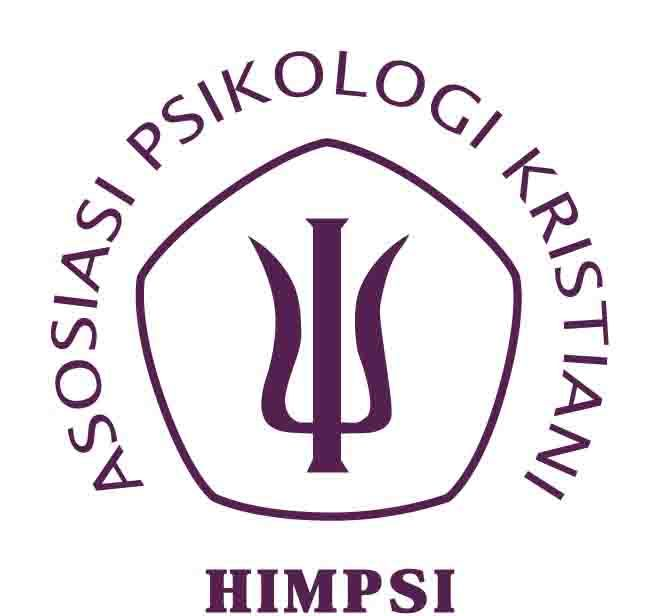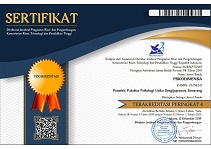PERAN SELF-AWARENESS DAN EGO SUPPORT TERHADAP KEPUASAN HIDUP REMAJA TIONGHOA
Abstract
ego support on the life satisfaction of adolescence. Participants were 223
subjects (19-21 years). Collecting data by using questionnaires such as: selfawareness,
ego support, and the life satisfaction of adolescence. Data was
analyzed with multiple regression via SPSS 16.0 software program. Found was
the impact of self-awareness on life satisfaction (r2 = .052, t = 3.467 , p = .001
< .01), the impact of ego support on life satisfaction (r2 = 0,219, t = 7.877, p =
0,000 < 0,01), and the impact of self-awareness and ego support on the life
satisfaction of adolescence (r2 = 0,.243, F = 35.307, p =0, .000 < 0,01).
Keywords
Full Text:
PDFReferences
Aboud, F.E., Mendelson, M.J., & Purdy, K.T. (2003). Cross-race peer relations and Friendship quality. International Journal of Behavioral Development, 2 (7), 165- 175.
Adebayo, S. O & Arogundade, O B (2011). The Predictive Influence of Extraversion and Neuroticism on Life Satisfaction Judgments of Adults in Ado -Ekiti, Nigeria. British Journal of Arts and Social Sciences.3 (1), 38-49.
Andrén. U (2012). Self-awareness and self-knowledge in professions: Something we are or a skill we learn. Göteborg, Sweden: University of Gothernburg.
Auzoult ,L and Hardy-Massard, S (2014). Desirability Associated with the Expression of Self- Consciousness in a French Population. Swiss Journal of Psychology, 73 (3), 183–188. Boyd, D & Bee, H. (2012). The Developing Child. Boston: Pearson.
Brill, R.R. (2000). Emotional Honesty and Self- Acceptance. USA: XLibris Corporation.
Comptom, W.C. (2005). An Introduction to Positive Psychology. Australia: Thomson wadsworth.
Cillessen, A. H.N., Jiang, X.L., West, T.V., & Laszkowski, D.K . (2005). Predictor of dyadic friendship quality in adolescence. International Journal of Behavioral Development, 2 (29), 165-172.
Dariyo, A. (2015). Persahabatan, Kecerdasan Emosi dan Kepuasan Hidup Remaja. (Laporan Penelitian, Tidak Diterbitkan). Jakarta: Lembaga Penelitian dan Publikasi Ilmiah Universitas Tarumanagara.
Diener, E. (2005). Guidelines for National Indicators of Subjective Well Being and Ill Being. Illinois, USA: University of Illinois.
Diener, E., Oishi & Lucas, (2015). National Accounts of Subjective Well-Being. American Psychologist, 70, (3), 234–242.
Diponegoro, A, M. (2004). Analisis Faktor Kepuasan Hidup Remaja. Phronesis, Jurnal Ilmiah Psikologi Terapan, 6 (12), 121- 133.
Dowler, C. A., Hinkle, V.A., Gibson, N., Hinkle, K. T., Wiley, E and Fiester, H. R. (2015). A Predictive Model for Student Success on the Georgia High School Science Graduation Test. International Interdisciplinary Journal of Scientific Research, 2 (1), 41-59.
Duval, T. S & Silvia, P. J. (2002) Self-Awareness, Probability of Improvement, and the Self-Serving Bias. Journal of Personality and Social Psychology, 82, ( 1), 49 – 61.
Eid, M & Larsen, R.J. ( 2008). The Science of Subjective Well-Being. New York: The Guilford Press. Fridayanti. (2013). Pemaknaan Hidup (meaning in life) dalam kajian Psikologi. Psikologika, 18 (2), 189- 198.
Goetzmann, L., Scholz, U, Dux, R, Roellin, M, Boehler, A, Muellhaupt, Noll, B, G, Wüthrich, R. P., and Klaghofer, R (2012). Life Satisfaction and Burnout Among Heart, Lung, Liver, and Kidney Transplant Patients and Their Spouses. Swiss Journal of Psychology, 71 (3), 125–134.
Heintzelman, S.J & King, L.A. (2014). Life Is Pretty Meaningful. American Psychologist, 69 (6), 561–574.
Janozs, M., Blanc, M.L., Boulerice, B., & Tremblay, R.E. (2000). Predicting Different Types of School Dropouts: A Typological Approach With Longitudinal Samples. Journal of Educational Psychology, 92 (1), 171- 190.
Kasimatis, M. D. & Guastello, D. D. (2012). Parenting Style Trumps Work Role in Life Satisfaction of Midlife Women. Journal of Articles in Support of the Null Hypothesis, 9 (1), 51-59.
Kail, R.V & Cavanaugh, J. C (2010). Human Development: A Life Span View. Australia: Wadworth Cengage Learning.
Kumalasari, F & Ahyani, L.N. (2012). Hubungan Antara Dukungan Sosial Dengan Penyesuaian Diri Remaja Di Panti Asuhan. Jurnal Psikologi Pitutur, 1 (1), 21-31.
Lamanna, M.A & Riedmann, A. (2012). Marriages, Families and Relationship. Australia: Wadworth Cengage Learning.
Lyons, M. D. Otis, K. L. Huebner, E. S, and Hills, K. J. (2014), Life Satisfaction and Maladaptive Behaviors in Early Adolescents. School Psychology Quarterly, 29 ( 4), 553–566.
Masriah, A., Putri, M.A., & Radiaswati, D.R.A. (2012). Perbedaan Harga diri dan Subjektif Well Being antara Remaja dengan Orangtua Lengkap dan Bercerai. Jurnal Mind Set, 4 (1), 65-69.
Nisfianoor, M. (2013). Pendekatan Statistik Modern. Jakarta: Universitas Trisakti Press.
Papalia, D.E., Olds, S.W, & Feldman, R.D. (2009). Human Development Boston:McGraw-Hill.
Patnani, M. (2012). Keabahagiaan Pada Perempuan. Jurnal Psikogenesis, 1 (1), 56- 64.
Rice, F.P & Dolgin, K.G. (2008). Adolescence: Development, Relationship and Culture. (12th edition). Boston: Pearson Education.
Santrock, J.W. (2007). Adolescence. Boston: McGraw-Hill.
Schimmack, U (2009). Well- Being: Measuring Well- Being in the SOEP. Berlin: Duncker & Humblot, Smollers Jarbuch, 129, 1-9.
Steinberg, L. (2011). Adolescence. (9th edition). Boston: McGraw-Hill.
Thomasson, A.L. (2006). Self awareness and Self Knowlwedge. Psyche, 2 (16), 1-15.
Wibowo, M. W & Susanto, D.Y (2014). Dinamika Dukungan Sosial pada Prestasi Siswa Sekolah Dasar: Suatu Pendekatan Indigenous Psychology. Jurnal Psikologi Tabularasa, 9 (1), 24-29.
Yamawaki, N, Nelson, J. A. P and Omori, M., (2010). Self-esteem and life satisfaction as mediators between parental bonding and psychological well being in Japanese young adults. International Journal of Psychology and Counselling. 3 (1), 1- 8.
DOI: https://doi.org/10.24167/psiko.v15i2.991
Print ISSN : 1411-6073 | online ISSN : 2579-6321 View My Stats

This work is licensed under a Creative Commons Attribution 4.0 International License.




















